by Deep Green Resistance News Service | Apr 30, 2018 | Protests & Symbolic Acts
by Survival International
Thousands of indigenous people gathered in Brazil’s capital this week, to protest against plans to destroy their lands and lives.
The Indians, from tribes across the country, painted the streets with “blood,” marched through the city, demonstrated at government buildings, and called for their rights to be respected.
Sonia Guajajara, an indigenous leader and candidate for the Vice-Presidency in Brazil’s upcoming general election, said: “We are denouncing the genocide of our people…This is the most suffering we’ve experienced since the dictatorship. By staining the streets red, we are showing how much blood has been shed in our fight for the protection of indigenous lands… The fight goes on!”
The protest marks Brazil’s “Indigenous April” and follows the annual “Day of the Indian,” 19 April, when the country’s President often announces some progress in the protection of indigenous peoples’ ancestral lands. This year, no such announcements were made. Instead, it was reported that the head of the government’s Indigenous Affairs Department would be replaced, as he was not fulfilling the demands of anti-indigenous politicians and ranchers.
Politicians linked to the powerful agribusiness lobby are pushing through a series of laws and proposals which would make it easier for outsiders to steal indigenous peoples’ lands and exploit their resources.
This would be disastrous for tribes across the country, including the Guarani, who suffer one of the highest suicide rates in the world, as most of their land has been stolen for cattle ranching and soya, corn and sugarcane plantations.
Adalto Guarani told Survival International of the politicians’ plan: “Please help us destroy this! It’s like a bomb waiting to explode, and if it explodes, it will put an end to our very existence. Please give us a chance to survive.”
And uncontacted tribes, the most vulnerable peoples on the planet, could be wiped out if their lands are opened up. Tribes like the uncontacted Kawahiva and Awá are on the brink of extinction as they live on the run, fleeing violence from outsiders. But if their land is protected, they can thrive.
Survival International and its supporters in over 100 countries are working in partnership with tribes across Brazil to prevent their annihilation and the extinction of their uncontacted relatives.
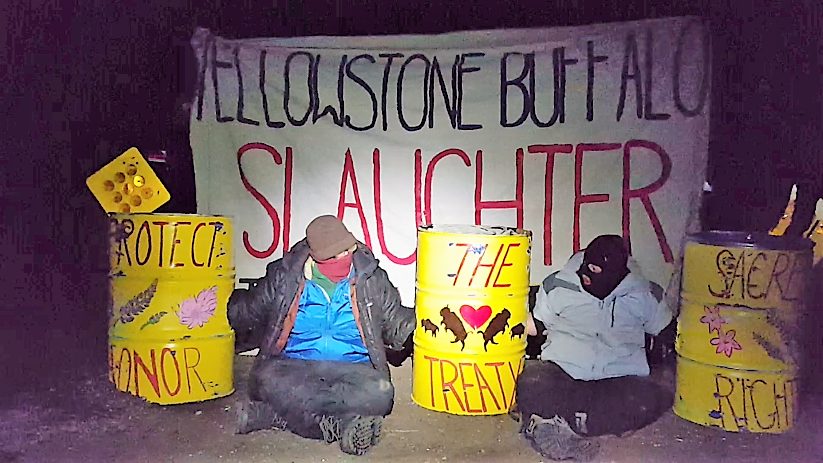
by DGR News Service | Mar 16, 2018 | Indigenous Autonomy, Obstruction & Occupation
March 16th 2018
For Immediate Release
Media Contact: Talon Brings Buffalo
406-404-9131
Stephens Creek Trap, Yellowstone National Park
March 16th 2018
Hours before dawn on Friday March 16th, two members of the Wild Buffalo Defense collective arrived at the gate of Yellowstone National Park’s Stephens Creek Buffalo capture facility. They blocked the gate with three 55 gallon drums filled with concrete, locking their arms inside the barrels. The three 1000 pound drums blocked access to the facility, preventing livestock trucks from taking the wild buffalo to slaughter. This action came in the wake of a similar event last week at the Stephens Creek Trap, where two buffalo protectors locked themselves to the hydraulic squeeze shoot using a metal pipe.
Wolf, the first individual locking down, described why he was taking the action: “My father is from Michaocan, Mexico, so I have both native and colonizer blood. Since I wasn’t raised in a native setting, this is my way to give back to the native community. I’m from Illinois — it’s called the Prairie State, and there’s less than one one-hundredth of the prairie left. It’s all strip malls and corn fields…I don’t like seeing just concrete and steel. Seeing how peaceful the buffalo are and how strong they are, they go through enough hardship in their lives in the forest and the plains and then with what Yellowstone National Park is doing to them they still carry on. They inspire me to keep going.”
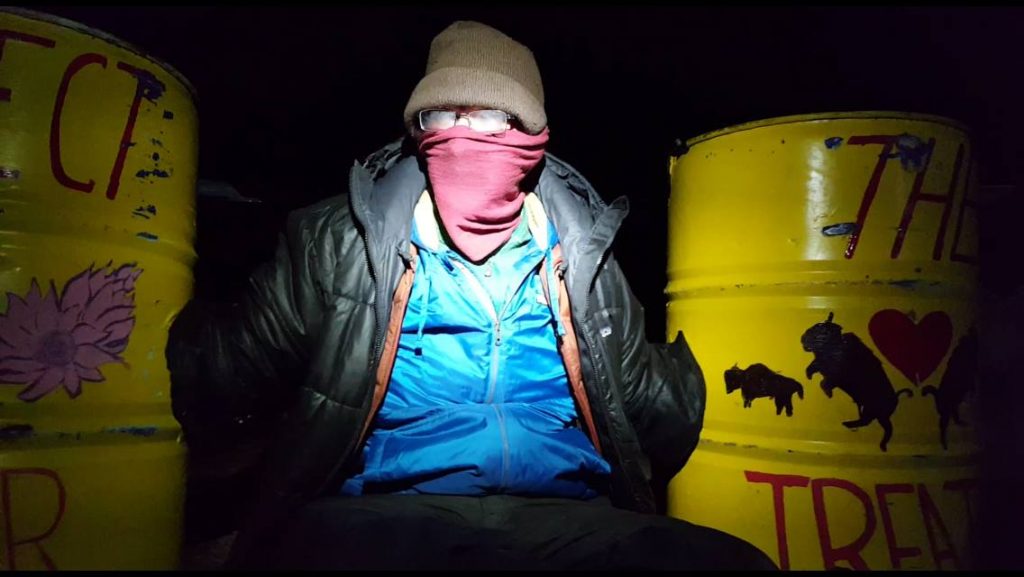
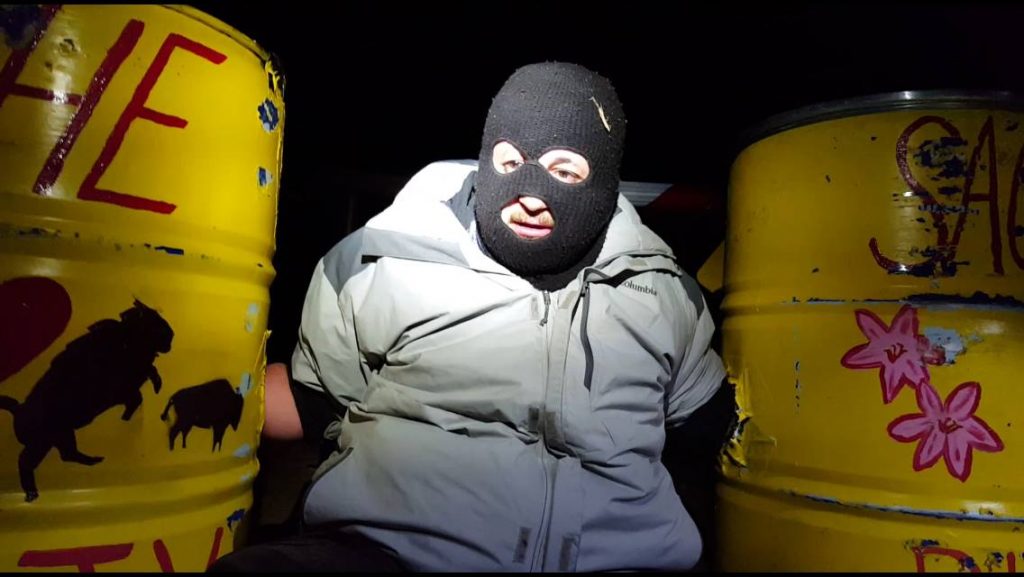
Coyote, the other individual blocking the gate, said: “I’m doing this to get a better understanding of what is really going on and to protect the buffalo and the lands that they roam. I feel like I have been lost inside…but now that I’m here I feel more combined with myself, with others, and with knowledge and understanding. Whenever I’m with the buffalo I feel like my heart runs with them. When I’m with them they already know the questions, they already know the answers, and I don’t have to respond because they already know. I think it’s a good thing for people to learn. There’s not a day in this world where you’re not able to learn something. What we’re doing is something we love to do and we only live once so we should do what we love to do and if anybody wants to come out and join and learn this experience then they should.”
The barrels were painted with two phrases, “Protect the Sacred” and “Honor the Treaties.” The words highlight the fact that Buffalo are sacred creatures to the Plains Indians. Blackfeet and Lakota prophecies say that when the wild buffalo return, the people and the earth will be healed. Yellowstone National Park currently captures and slaughters about 25% of the herd every year. If this mismanagement of the population continues, these prophecies will… [press release ends].
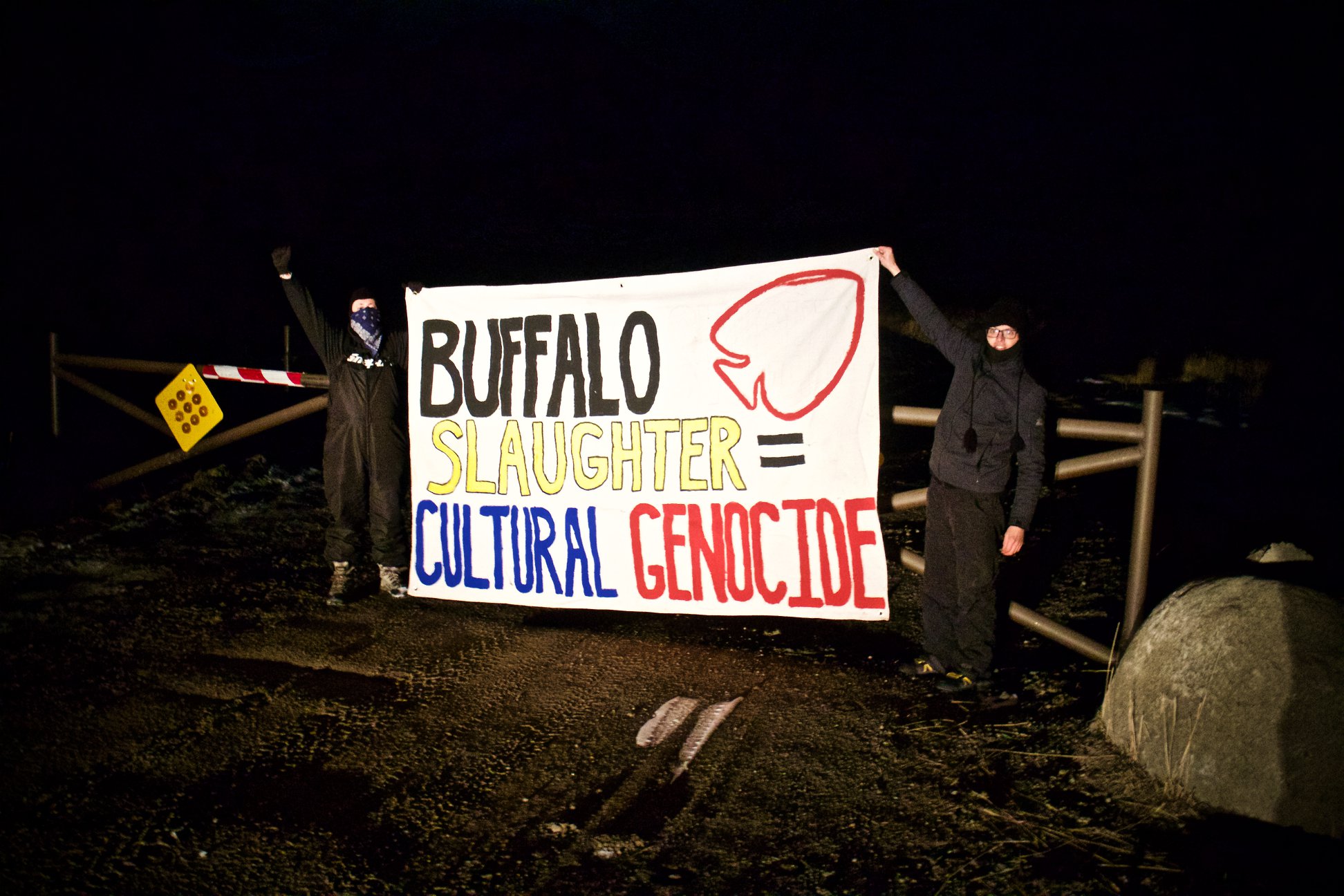
by DGR News Service | Mar 6, 2018 | Biodiversity & Habitat Destruction, Obstruction & Occupation
by Wild Buffalo Defense
Media Contact: Talon BringsBuffalo, 646-352-2126
An hour before sunlight on march 5th two members of the Wild Buffalo Defense collective named Cody and Crow descended from the hills onto Yellowstone National Park’s Stevens Creek buffalo trap and using a steel pipe, locked themselves to the bars of the “Silencer”, a hydraulic squeeze shoot that holds buffalo for testing, shipping and slaughter. In freezing temperatures the individuals blocked the buffalo processing facility and prevented the park from shipping wild buffalo to slaughter.
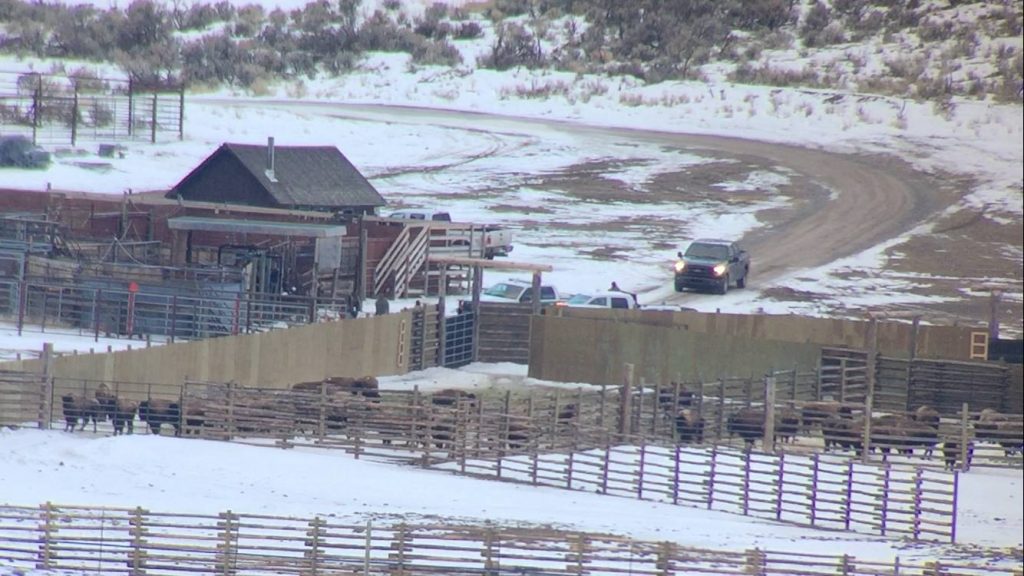 When asked why he was taking this action Cody stated, “I am standing with the plains Indians as a member of the Ojibwe tribe in Minnesota, I have a Blackfeet friend who helped me protect my territory from the line 3 pipeline and now I am here for him and the buffalo. I have a love for the people. That’s what my mom passed down to me. And I have love for the environment and animals and I feel like I have an obligation to protect them. If I have to put my body on the line to do so I will.”
When asked why he was taking this action Cody stated, “I am standing with the plains Indians as a member of the Ojibwe tribe in Minnesota, I have a Blackfeet friend who helped me protect my territory from the line 3 pipeline and now I am here for him and the buffalo. I have a love for the people. That’s what my mom passed down to me. And I have love for the environment and animals and I feel like I have an obligation to protect them. If I have to put my body on the line to do so I will.”
The two Yellowstone buffalo herds are the last free ranging, genetically pure, plains buffalo in the United States. These buffalo are decedents of the 23 that survived the buffalo extermination campaign that the US government implemented in the 1800s to starve the plains Indians into submission.
Today the Stevens Creek Buffalo Trap costs the Yellowstone Parks Service 3 million dollars per year to maintain and despite years of public opposition continues to operate their capture-for-slaughter facility within the park boundary. Activists and tribes allege that the Montana cattle lobby controls how the Parks Service manages of the wild buffalo. Crow, the other individual who locked himself to the facility stated “They say they need to kill the animals to stop the spread of Brucellosis, but the wild elk have Brucellosis and they are allowed to roam free because the cattle industry is not worried about elk competing for grass and the state receives income from the elk hunting permits.” Every year the facility captures and sends roughly 1000 animals of the 4000 wild buffalo population to slaughter.
While the two individuals locked themselves to the shoot, some activists gathered at the gate of the facility with banners reading “Wild buffalo slaughter = cultural genocide.” Their signs spoke to the connection between the culture of the plains tribes and the wild buffalo, suggesting that by exterminating the last wild buffalo, Yellowstone is effectively attempting to do the same to the culture of the plains tribes. The non-violent direct action came in the wake of a decision by the Montana department of livestock and the animal plant and health inspection service to deny the Fort Peck Indian reservation the right to receive wild buffalo from the park.
To Support Wild Buffalo Defense please contribute to our campaign and legal fund!
Campaign Fund: https://www.youcaring.com/wildbuffalodefense-1119076
Legal Fund: https://www.youcaring.com/wildbuffalodefense-1119210
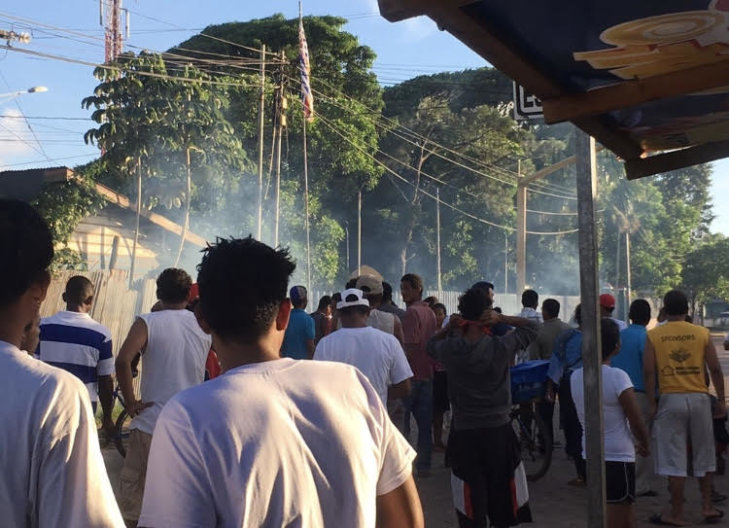
by Deep Green Resistance News Service | Nov 15, 2017 | Colonialism & Conquest
by Brett Spencer / Intercontinental Cry
On Saturday, Nov. 11, members and supporters of the Miskitu indigenous party, Yapti Tasba Masraka Nanih Aslatakanka (YATAMA) crowded into their burnt down compound to celebrate their thirtieth anniversary. Over one thousand people were present, including many from surrounding villages that came to listen to the party’s political leader and congressman, Brooklyn Rivera.
The celebration came just days after riot police and military were flown in from Managua to control dissent following Nicaragua’s municipal elections. YATAMA and its supporters roundly denounced the election results on Nov. 5 that deposed them of control of the municipalities of Bilwi, Waspam, Prinzapolka and Awaltara.
YATAMA’s supporters, who took to the streets in protest of the results—which YATAMA deemed fraudulent—were met with violence by military and paramilitary forces carrying automatic weapons.
“We were protesting electoral fraud,” said the party’s leader, Brooklyn Rivera. “We were protecting our people. We were not expecting the military or the police to attack. Our youth tried to resist the attack, but you cannot fight back with rocks when they have machine guns.”
The violence in Bilwi reached a new low when YATAMA’s headquarters was set on fire Monday night. At least part of the event was caught on film, but no one has taken responsibility for setting fire to the compound.
YATAMA and many residents of Puerto Cabezas-Bilwi say that local residents are not responsible.
Brooklyn Rivera, who was in his office when the building was set ablaze, insists that it was the police and army. “I was inside there when they attacked. It was not the Sandinista youth or local Sandinista members. It was the army and the police who did this, not our local people. This violence was organized from Managua,” he said.
IC confirms that party leadership has been harassed, attacked and threatened by military and paramilitary personal as government forces laid siege to the city. “The burning of the YATAMA house, the radio station and the destruction of the Indian statue came directly from the special forces of the police, not from some local Sandinista group,” said Mr. Rivera. “The leadership of YATAMA is not fighting, we are here accompanying our people.”
These allegations suggest that the post-election unrest in Bilwi is not a local conflict of “Miskitu versus Miskitu,” but rather a government crackdown on indigenous resistance. There are currently one hundred and three political prisoners in Bilwi following the municipal elections, and the arrests of protesters throughout the country show that distrust of the democratic process in Nicaragua is not isolated to the Atlantic Coast.
Mr. Rivera was pleased to have peace during the party’s celebration, and he is already planning a path forward to remain a pillar of support for the indigenous population. “We must rebuild, it is important that our people have staples of communication and resistance like our radio station to keep unity in our communities.”
It has been a difficult week for the party, as it comes to terms with the iron grip of militarization. The aftermath of the election has left many questioning if YATAMA should direct itself away from a political agenda, when each election is met with allegations of fraud and violence.
Mr. Rivera understands this sentiment and frustration, citing a recent resolution by the Inter-American Court of Human Rights, he commented, “We are violating our own rights by participating in this election.”
When asked why the national government has exhausted so much power to prevent YATAMA from succeeding, Mr. Rivera did not hesitate. “They are trying to colonize our people and our land to control our natural resources. We resisted, and now they are trying to totally destroy indigenous organization.”
As relations between YATAMA and the Ortega administration continue to deteriorate, residents are beginning to accuse the government of resorting to the same kind of reactionary violence seen in the 1980s. For now, the city remains peopled with military personnel, as YATAMA plans to reopen its radio station and reconstruct its pillars of resistance.
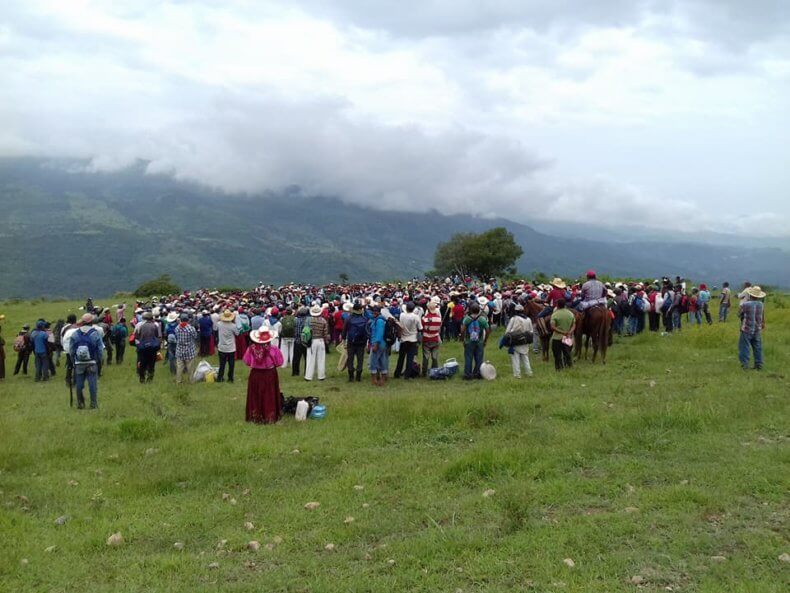
by Deep Green Resistance News Service | Sep 26, 2017 | Reclamation & Expropriation
Featured image by Octaviano Díaz Chema
by Tracy Barnett / Intercontinental Cry
HUAJIMIC, Nayarit, Mexico — A century-old land conflict has flared up again in the Western Sierra Madre, deepening already raw tensions in the wake of the May 2017 assassination of two Huichol (Wixárika) leaders who fought to reclaim that land.
On Friday, the anniversary of last year’s equally contentious reclamation action, 1,200 indigenous Huichols hiked for three hours down a mountain into the contested valley of Huajimic to meet the court officials scheduled to sign over to them a bitterly contested piece of farmland.
The officials never arrived, however, because ranchers opposing the restitution staged a roadblock, and police never showed up to enforce the action. Now the Huichols say they’ll stay put on the remote piece of farmland until the restitution is complete, setting the stage for a potentially violent standoff of uncertain duration.

Photo: Octaviano Díaz Chema
Friday’s restitution was to be the second in a series of legal procedures recognizing the wrongful possession of 10,500 hectares (nearly 26,000 acres) of Huichol land by the region’s mestizo ranchers more than 100 years ago.
The ranchers hold titles from the Mexican government dated around 1906, but the Huichol people hold land grants dating back to the 1700s from the Spanish crown.
Since last year’s hard-fought restitution, the leader of that effort, Miguel Vázquez Torres, was shot to death by a truck full of armed gunmen, as was his brother Agustin. Many suspect they were targeted because of their outspoken support of the land restitution.
On Sept. 22, 2016, after a series of lawsuits were decided in favor of the Huichol community of San Sebastián Teponohuaxtlán, they moved in to claim their first parcel, a 184-hectare (454-acre) hillside ranch about 5 miles from the ranching town of Huajimic. That action was followed with a roadblock and threats of violence. Since that time three Huichol families moved in to set up a homestead and begin farming, and faced repeated threats from residents of the nearby town of Huajimic.
This time, the contested tract is only 63.7 hectares (157 acres), but for the Huichol community, it represents the leading edge of their fight to reclaim their ancestral homelands. For the ranchers, it represents the line they must hold to prevent the dispossession of lands that have been in their families for generations.
The day before the scheduled restitution, local and state officials met in the Nayarit state capital of Tepic with Agrarian Tribunal Magistrate Aldo Saúl Muñoz López and assured him that public security forces would be present to prevent violence, said Cristián Chávez, a territorial expert representing the Huichol community of San Sebastian, who was present at the meeting and the subsequent roadblock.
The promised police forces never showed up, and a caravan including various court officials, a state human rights observer, attorneys and media representatives made their way through the hilly terrain, driving for more than an hour before confronting the roadblock. Several pickup trucks blocked the road and about 40 individuals were on the scene, said Chávez.
Magistrate Muñoz López got down from his truck and informed the ranchers that he was there to carry out an order from the court, and politely asked them to let the caravan pass, according to a report by Agustín del Castillo from Milenionewspaper. Ranchers flatly denied passage.
Given that there was no law enforcement present, Muñoz López drew up a document describing the circumstances that prevented the execution of justice, and expressed his intention to seek the means to follow through with the legal decision as soon as possible, said Chávez. He also reassured the ranchers that he would take their concerns to the authorities in the state and federal government.
Carlos González was visibly upset with the circumstances, according to del Castillo’s report. “We blame the governor of Nayarit, Antonio Echavarría, his secretary general of government and his attorney general, for the violence that could be caused by this situation, since 1,200 comuneros have come down to the property and taken possession of it, and given the traffic and food blockades on the part of the ranchers, the situation may become unsustainable,” he said with obvious annoyance.
The Mexican government has come under severe criticism for its lack of action in the case, rejecting repeated requests by Huichol leaders and ranchers alike to reimburse ranchers with federal funds designated to help prevent land conflicts.
The spokesman for Mexico’s Secretariat of Agrarian, Territorial and Urban Development, which is charged with resolving land disputes, said the agency lacks the resources to get involved and is already faced with more than 300 pending land conflicts.
Huichol representatives have taken their case directly to the public in videos posted on Facebook Saturday. They say they will continue to occupy the land until the court officials arrive and formalize the restitution. In one of them, a camera pans a massive crowd standing in a field, with mountains in the backdrop. Felipe Serio Chino, president of the community’s security council, steps forward.
“Today, Sept. 22, 2017, more than 1,000 comuneros (Huichol community members) gathered here in this place to demand of Magistrate Aldo Raul Muñoz López, who is in charge of Tribunal 56 in Tepic, Nayarit, that he deliver this land into our possession as it was programmed. All these comuneros are awaiting your presence. Without it, we will stay until we achieve the objective we came here for.
“We send a salute to Mr. Aldo but we also ask him not to be a coward, to not be afraid, to not allow anyone to prevent him from doing his duty… the law has recognized it; we are only demanding what is ours.”










